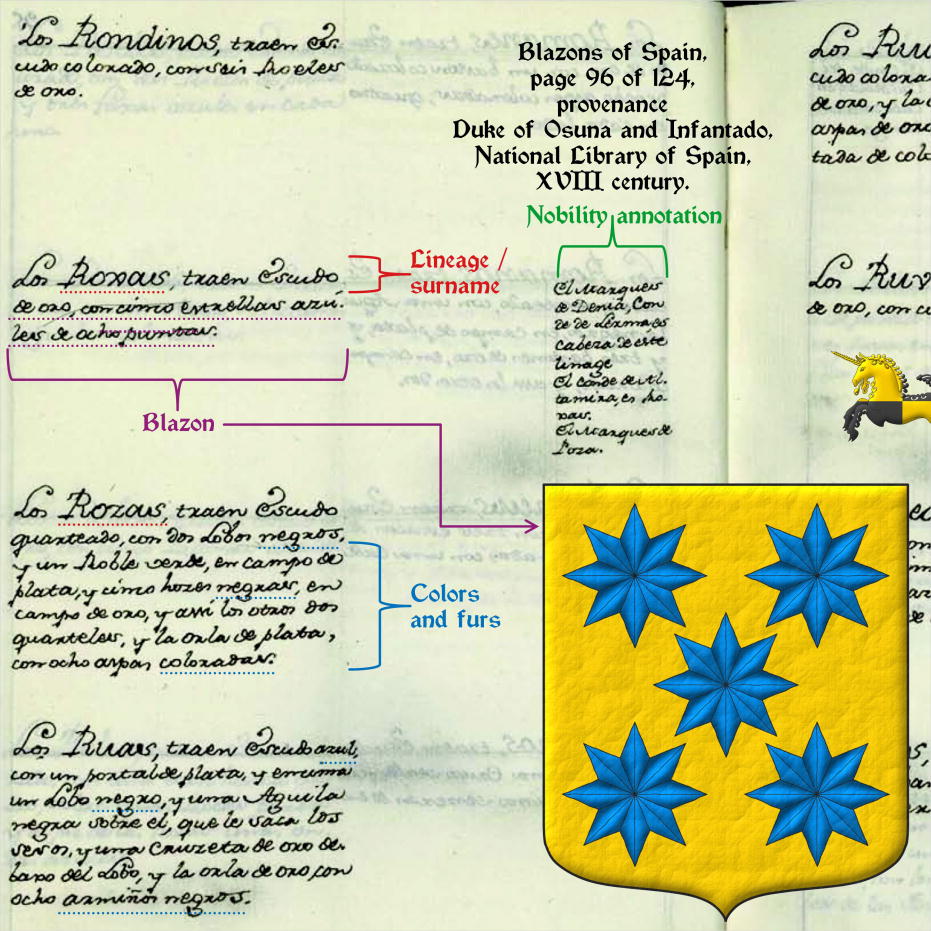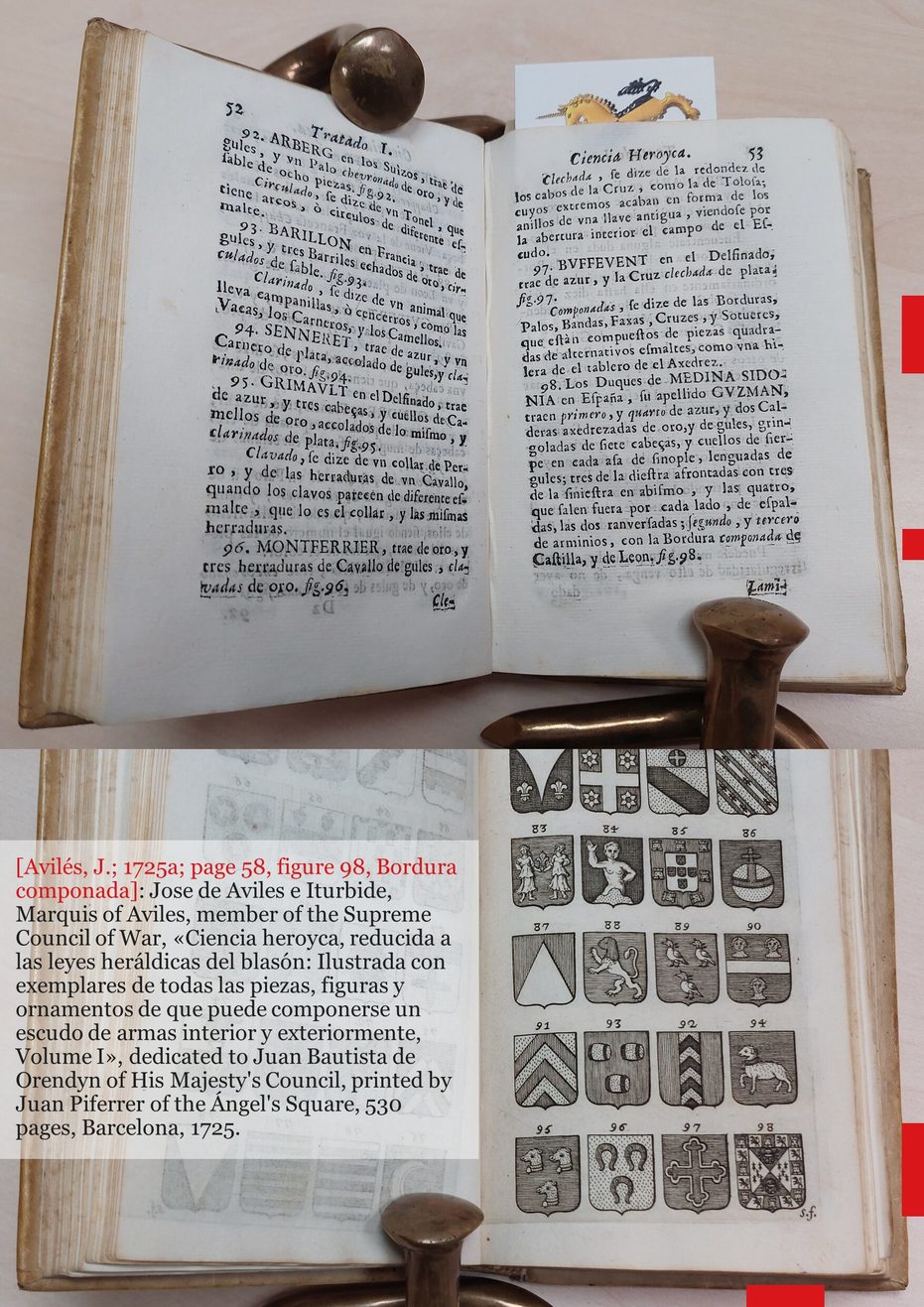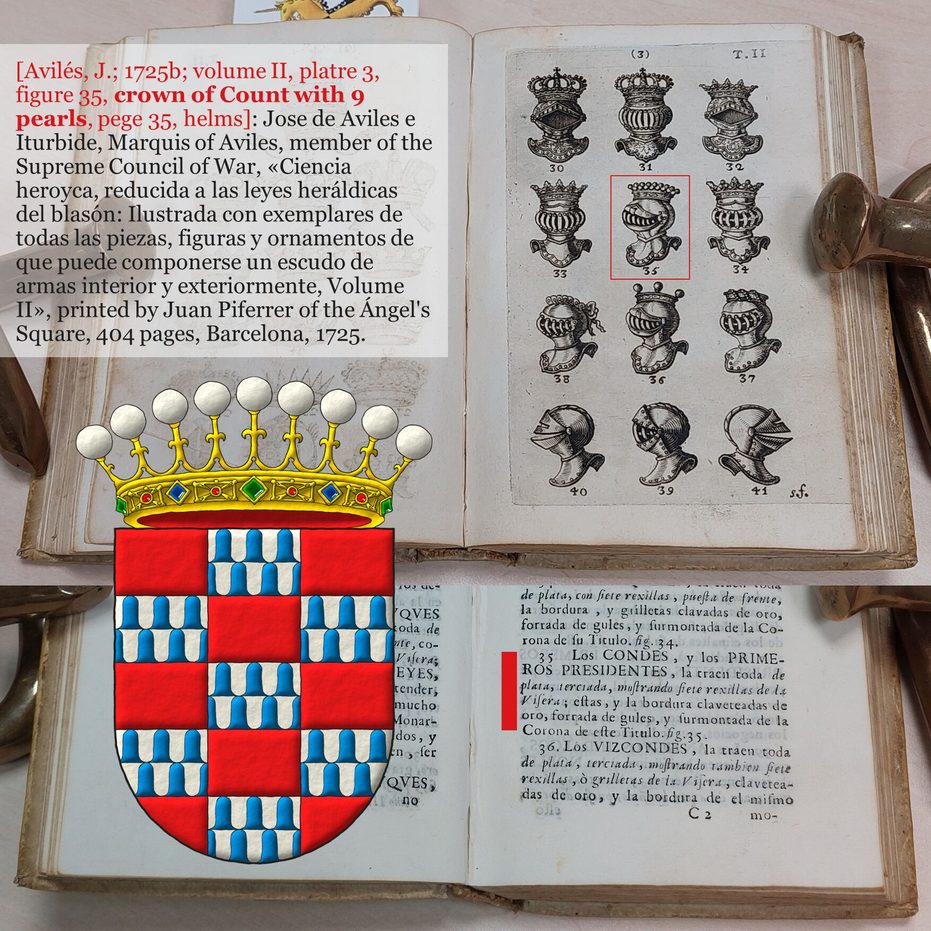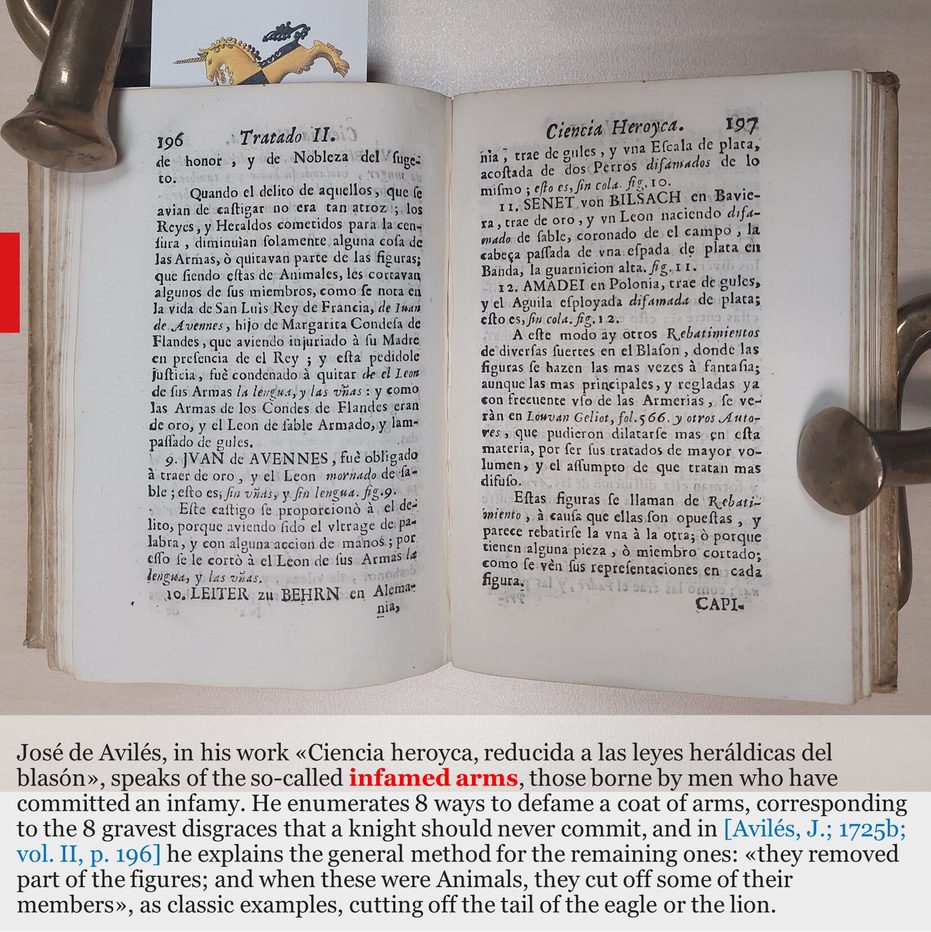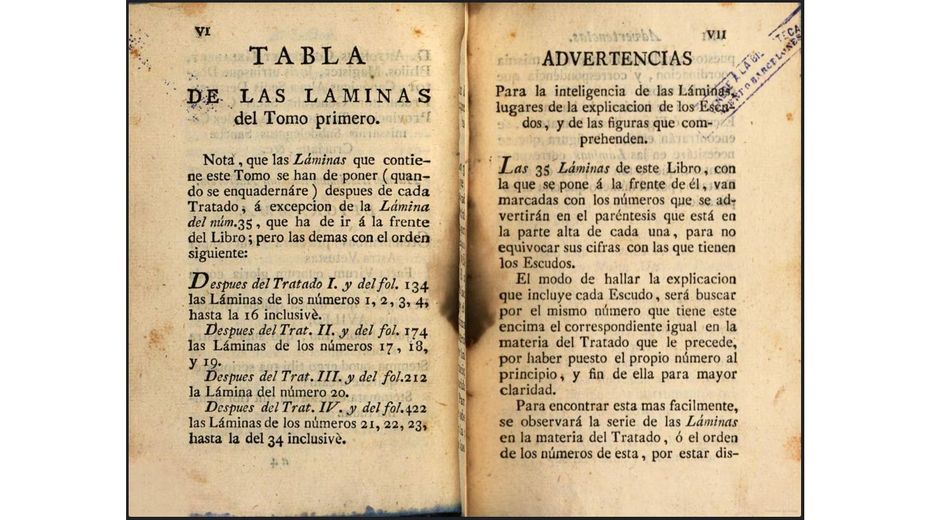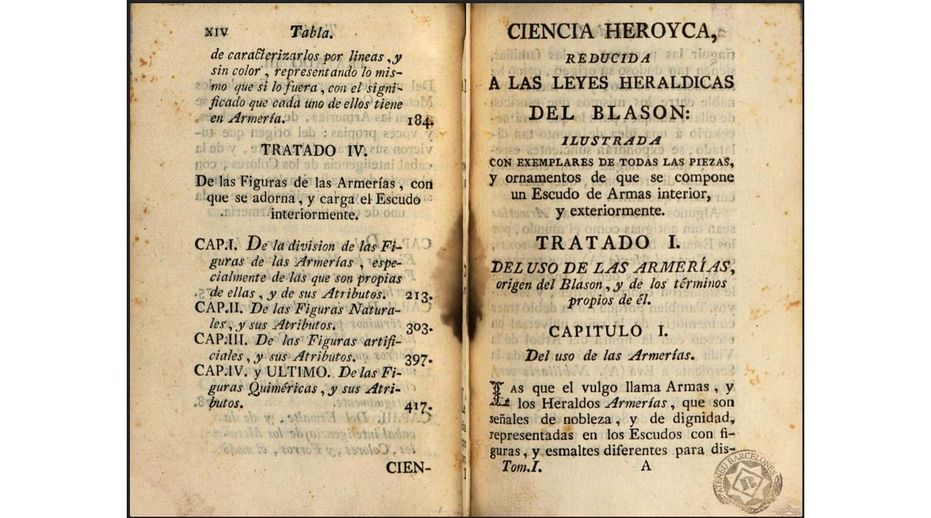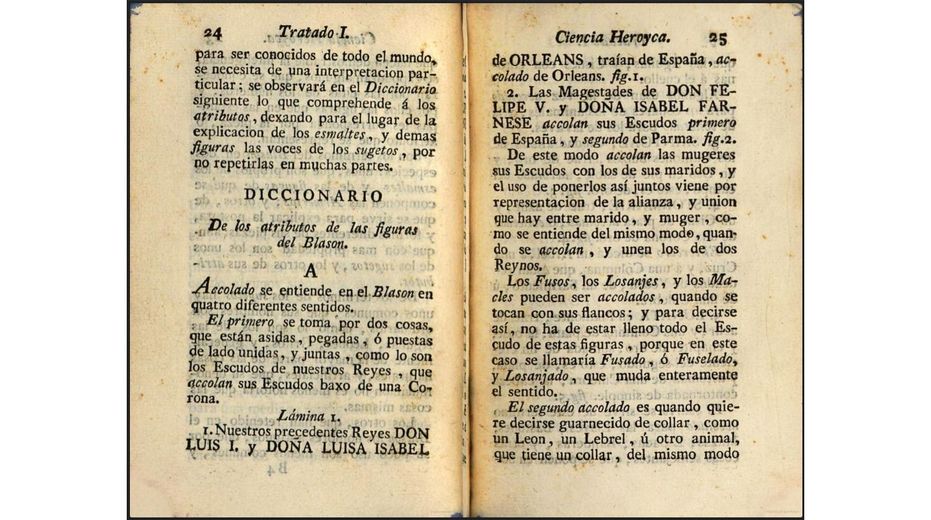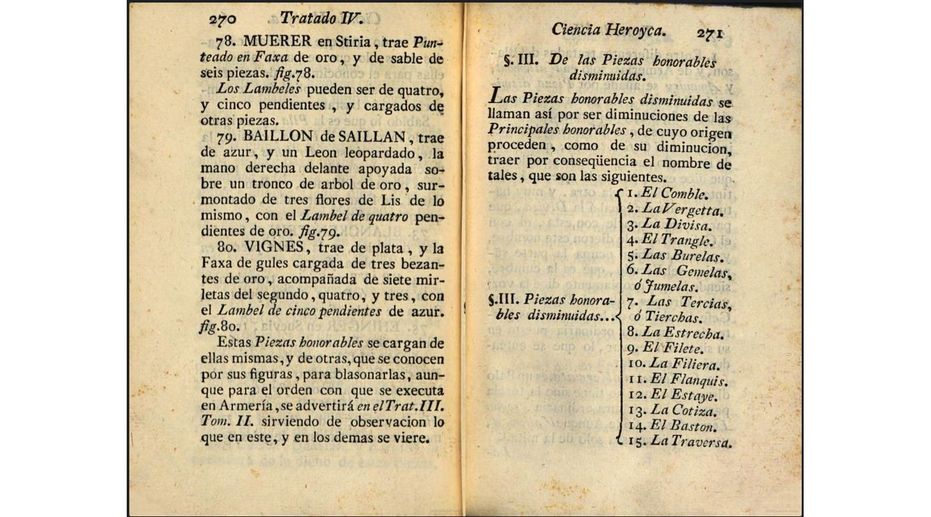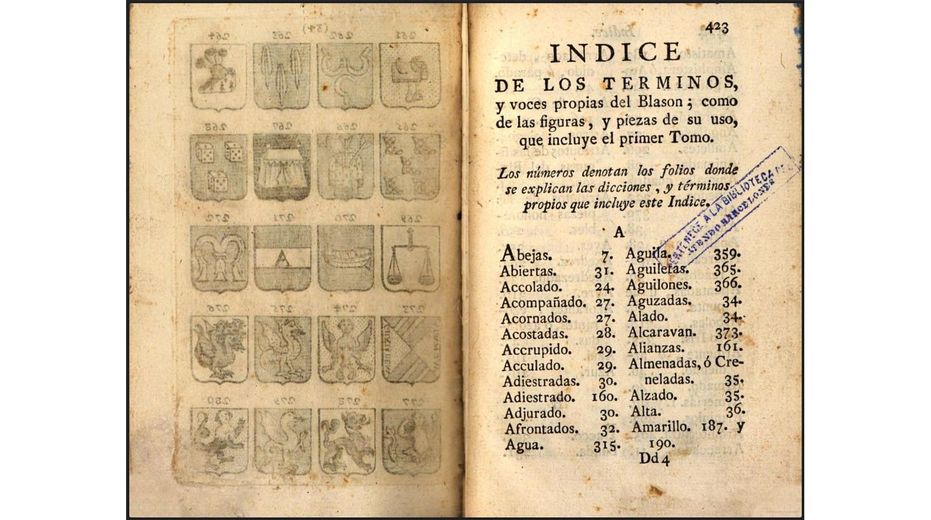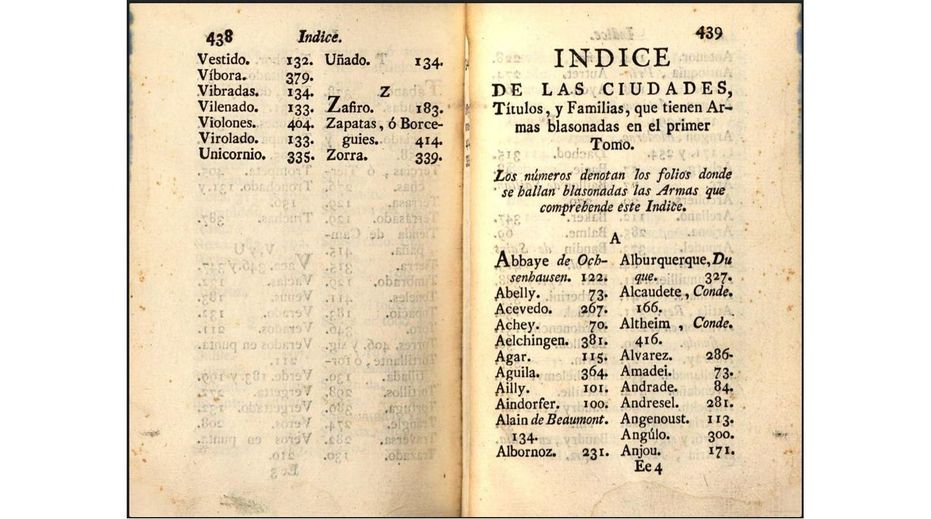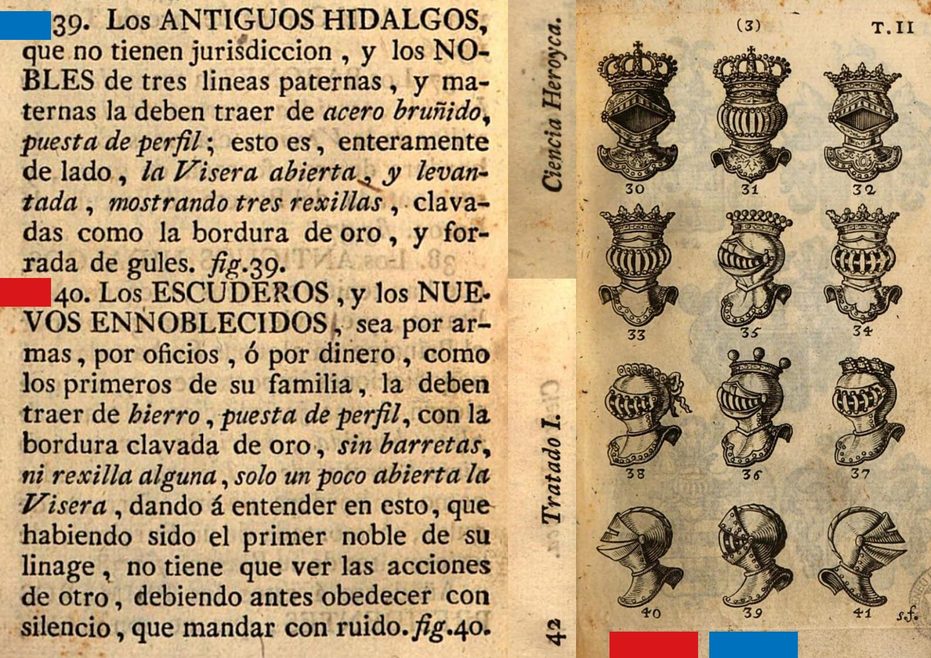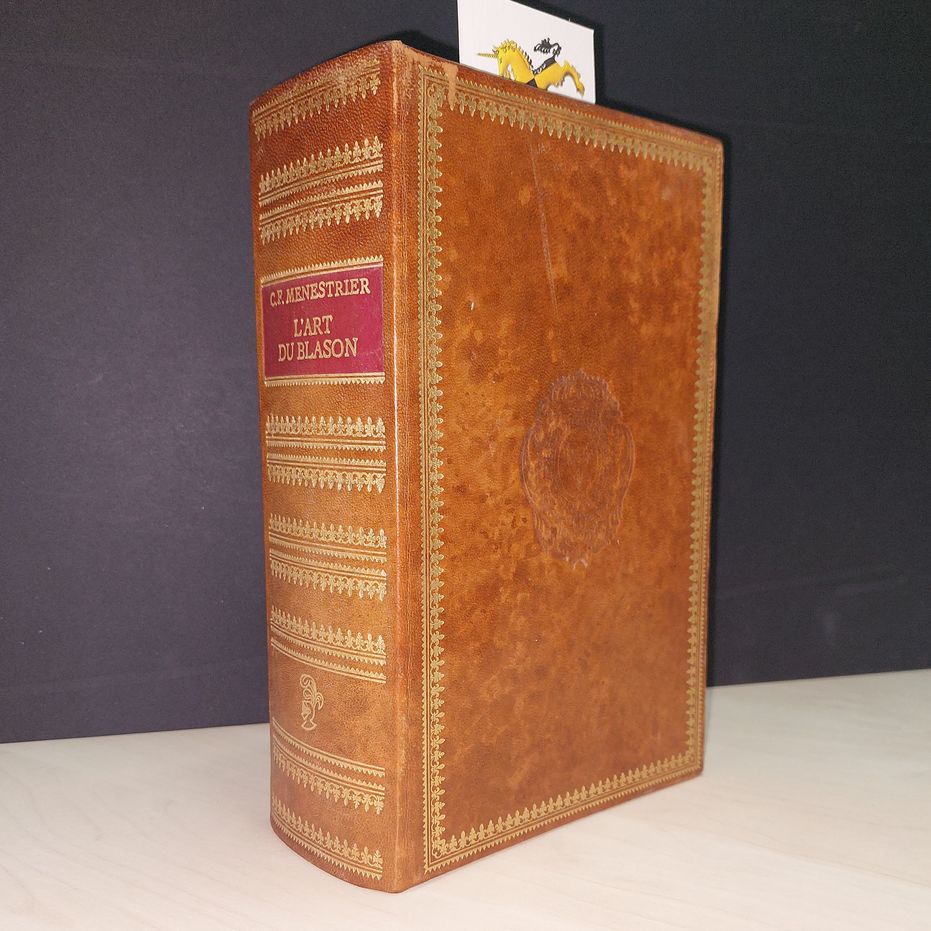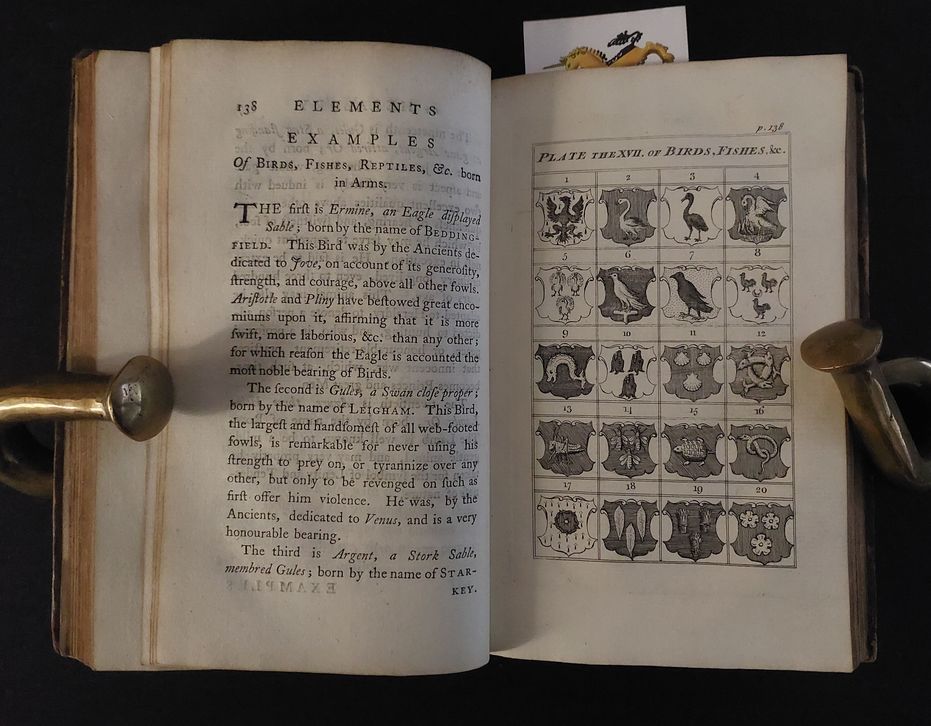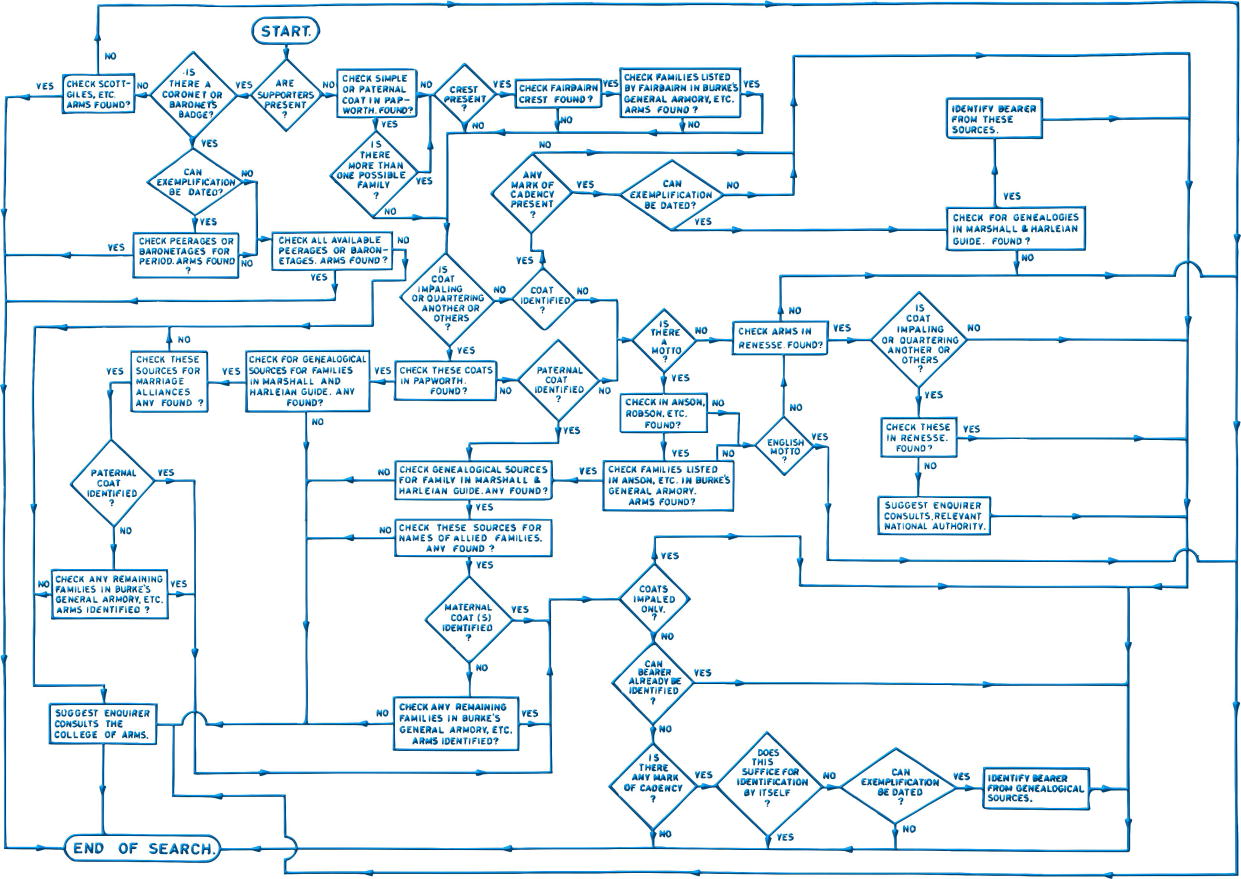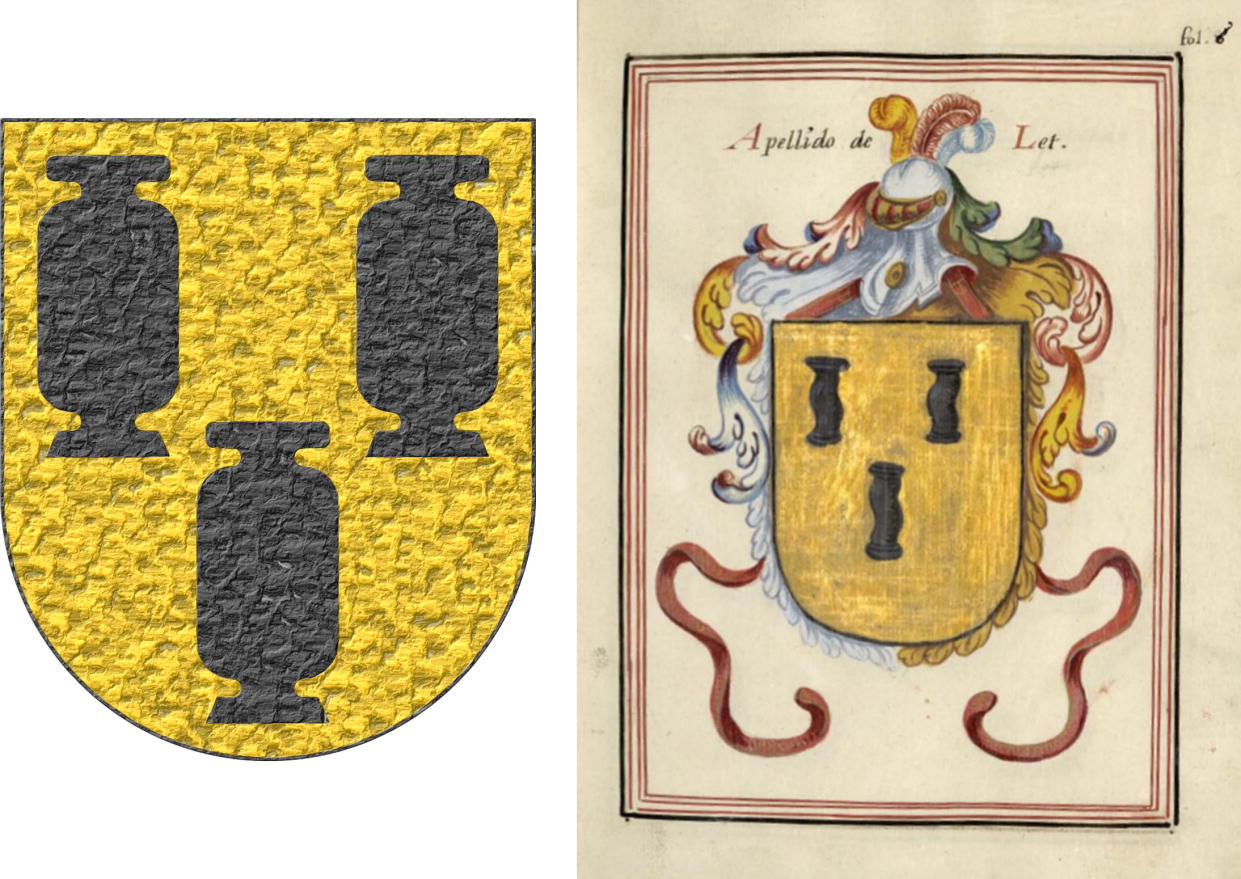Century XVIII


![Ver [Anonymous; 1800a] en referencias bibliográficas. Libro abierto, hojas de plata, filo de oro, guardas de gules, tapas de sable.](../css/Libro.Bibliografia.png)
Anonymous; 1800a
Anonymous, «Armerías de España», 124 double pages, title in the page 9, provenance Duke of Osuna and Infantado, 1800.
Content
The book has no index and its content, written by hand, is as follows:
- Pages 1 through 8 are blank.
- On page 9, title, the letter A begins and surnames Abarca, Abendaño, Abeo, Ablitas and Abrego in large handwritten and the blazon in small handwritten (except for the end of the book on page 123, the unknown author seems to write more about surnames than about lineages).
- On page 10, the surnames with the letter A continue and their blazon both in small handwritten.
- On page 23, the letter B begins, its surnames and their blazons, for example, the Barrasas, in the page 25, «Or, six Lions proper, combatant».
- On page 30, the letter C begins, it is followed by the letter Z on page 42, 29 surnames with Z was written before the letter D and Cocas and Cuacas, with the letter C, are inserted inside the letter Z.
- It follows in alphabetical order of surnames from page 46, where the letter D begins, to page 97 with the letter S, including in the S the surname Sánchez on page 99, as a lineage will be included at the end of the book, and it follows with the letter S until the page 104.
- On page 105 the letter T begins, surname Tabixas, Taboadas, Tafuxes, ...
- On page 109 jump from the letter T to the letter V, with the surnames Vacas, Vadillos,... and skipping the letter U.
- On page 119, it returns from letter V to U, in an unordered manner and without including the title with the capital letter U.
- On page 120, begins the letter X and also the letter Y.
- On page 122, the letter Z and only 3 additional surnames with Z, recall that the majority of the surnames with Z were included after the letter C.
- On page 123 he returns to the surname Sánchez by testimony of Pedro de Soto owner of the books of Armory of Spain of Andreas Heredia, King of Arms, and finally the unknown author copies the text for the surname Sánchez, those who were «hijosdalgos, en Cangas de Gobadonga» ~ Covadonga of Asturias and ends with a poem of 8 verses. Andreas Heredia, also known as Andrés Heredia, was King of Arms during the reign of Philip III of Spain, [Nieto y Cortadellas, R.; 1957a; Page 4]
- Beginning on page 124 are blank.
Bibliographical reference of century XVIII.
Classification: Manuscript, Armorial roll, In black and white and Castilian language.
The author is unknown.
Bibliographical reference mentioned in the following article:
External resources:
- Detail of this Armorial in the National Library of Spain.
- Bibliographic record of the National Library of Spain.
- Scanned Armorial in the National Library of Spain.
Internal resources: Osuna1800.ArmeriaEspaña.Manuscrito.pdf.


![Ver [Avilés, J.; 1725a] en referencias bibliográficas. Libro abierto, hojas de plata, filo de oro, guardas de gules, tapas de sable.](../css/Libro.Bibliografia.png)
Avilés, J.; 1725a
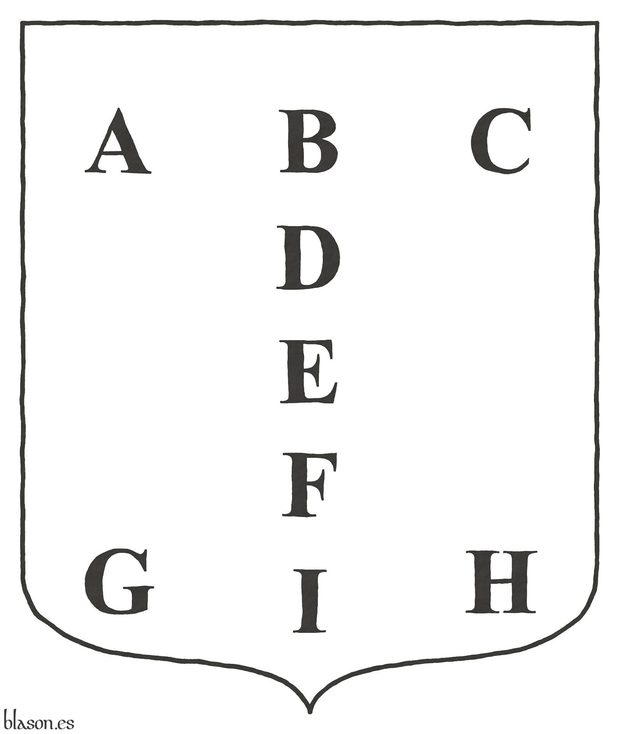
José de Avilés e Iturbide, Marquis of Aviles, member of the Supreme Council of War, «Ciencia heroyca, reducida a las leyes heráldicas del blasón: Ilustrada con exemplares de todas las piezas, figuras y ornamentos de que puede componerse un escudo de armas interior y exteriormente, Volume I», dedicated to Juan Bautista de Orendyn of His Majesty's Council, printed by Juan Piferrer of the Ángel's Square, 530 pages, Barcelona, 1725.
I also usually consult Volume I of the edition [Avilés, J.; 1780a].
Contents of Volume One
- Cover page.
- Dedication.
- Censor's review from 1724.
- Approval.
- To the reader.
- Epigram.
- Summary of privileges.
- Summary of the price.
- Plate index.
- Warnings.
- Errata sheet for each of the treatises.
- Additions.
- Table of the treatises.
- 378 pages for its 4 treatises: Treatise I with 3 chapters and a dictionary, Treatise II with 3 chapters, Treatise III with 3 chapters, and Treatise IV with 4 chapters.
- 34 plates with more than 650 coats of arms arranged at the end of each treatise, as follows: Plates 1 to 16 at the end of Treatise I, Plates 17 to 19 at the end of Treatise II, Plate 20 at the end of Treatise III, and Plates 21 to 34 at the end of Treatise IV.
- Index of terms, words, and figures specific to blazonry.
- Index of cities, titles, and families with coats of arms blazoned in this second volume.
Bordure compony
Bibliographical reference of century XVIII.
Classification: De bibliotheca, In black and white and Castilian language.
Author: Avilés e Iturbide, José.
Bibliographic reference mentioned in the following articles:
- Adrian V
- Baudry in France
- Bourgeois, lineage of Burgundy
- Criteria used by its title
- Dancetty, ratio, points and blazon
- Edmund Plantagenet
- Enrique Fernández Marqués, two supporters
- Ferdinand II of Leon
- Flanched, schemaat one-fifth
- Hector of Troy
- Hector of Troy, Sable
- Hufflepuff House with 2 badgers
- Innocent IV
- Leonor de Aquitania
- Navarre
- Nhf, Norsk Heraldisk Forening
- Oschoven of the Rhin
- Pile issuant from the base in the Dictionary of the Spanish Language
- Richard I of England
- The Heraldry Society of Scotland
- Triangulation 1, contre-embrassés, chapé, embrassé, and chaussé
- Triangulation 2, chaussé, contre-embrassé, embrassé, and chapé
- Triangulation 6, embrassé, chaussé, chapé, and contre-embrassé
- Triangulation 7, chaussé, contre-embrassé, embrassé, and chapé
External resources:
- Valencian Digital Library, records for the Volumes I and II.
- Valencian Digital Library, content of Volume I.
Internal resources: AvilesJ1725.Tomo.I.pdf.


![Ver [Avilés, J.; 1725b] en referencias bibliográficas. Libro abierto, hojas de plata, filo de oro, guardas de gules, tapas de sable.](../css/Libro.Bibliografia.png)
Avilés, J.; 1725b
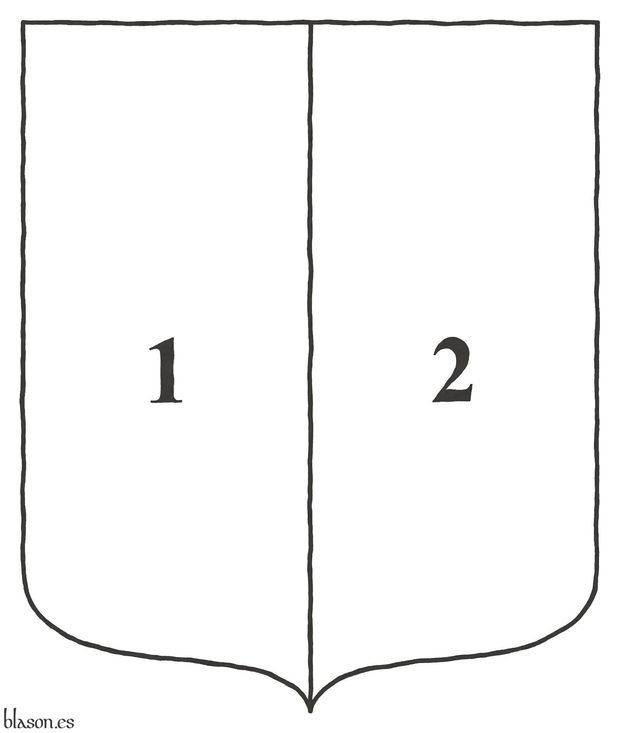
José de Avilés e Iturbide, Marquis of Aviles, member of the Supreme Council of War, «Ciencia heroyca, reducida a las leyes heráldicas del blasón: Ilustrada con exemplares de todas las piezas, figuras y ornamentos de que puede componerse un escudo de armas interior y exteriormente, Volume II», dedicated to Juan Bautista de Orendyn (Juan Bautista de Orendáin y Azpilicueta) of His Majesty's Council, printed by Juan Piferrer of the Ángel's Square, 404 pages, Barcelona, 1725.
I also usually consult Volume I of the edition [Avilés, J.; 1780b].
Contents of Volume Two
- Cover page.
- To the reader.
- Errata sheet for each of the treatises.
- Summary of the price.
- Table of the treatises.
- Plate index.
- Warnings.
- 319 pages for its 4 treatises: Treatise I with 6 chapters, Treatise II with 3 chapters, Treatise III with 4 chapters, and Treatise IV with 13 chapters.
- 25 plates with hundreds of coats of arms and illustrative figures arranged at the end of each treatise, as follows: Plates 1 to 16 at the end of Treatise I, Plates 17 to 19 at the end of Treatise II, Plates 20 to 24 at the end of Treatise III, and Plate 25 at the end of Treatise IV.
- Index of terms, words, and figures specific to blazonry.
- Index of cities, titles, and families with coats of arms blazoned in this second volume.
Crown of count
Infamed arms
Bibliographical reference of century XVIII.
Classification: De bibliotheca, In black and white and Castilian language.
Author: Avilés e Iturbide, José.
Bibliographic reference mentioned in the following articles:
External resources:
- Valencian Digital Library, records for the Volumes I and II.
- Valencian Digital Library, content of Volume II.
Internal resources: AvilesJ1725.Tomo.II.pdf.


![Ver [Avilés, J.; 1780a] en referencias bibliográficas. Libro abierto, hojas de plata, filo de oro, guardas de gules, tapas de sable.](../css/Libro.Bibliografia.png)
Avilés, J.; 1780a
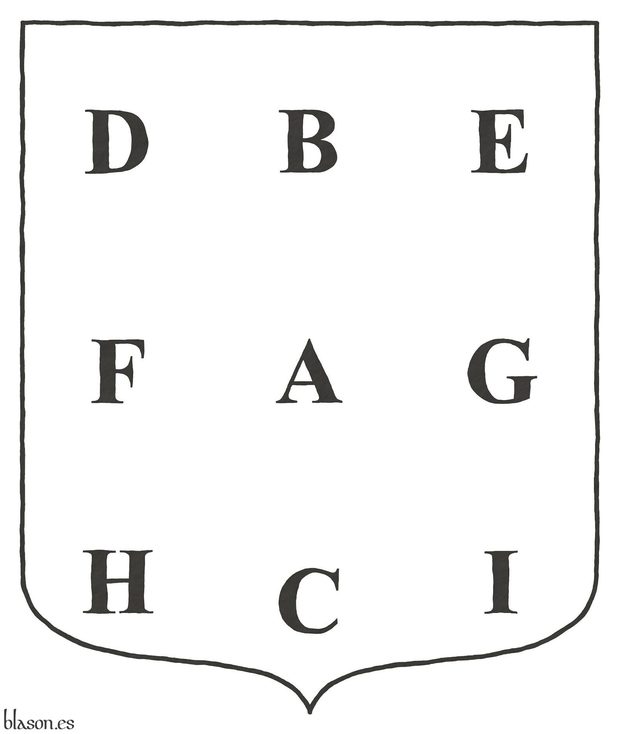
José de Avilés e Iturbide, Marquis of Aviles, member of the Supreme Council of War, «Ciencia heroyca, reducida a las leyes heráldicas del blasón: Ilustrada con exemplares de todas las piezas, figuras y ornamentos de que puede componerse un escudo de armas interior y exteriormente, Volume I», edition of Joaquín Ibarra, printer of his Majesty's Chamber, at the expense of the Company of Printers and Booksellers of the Kingdom, 526 pages, Madrid, 1780.
The first edition is [Avilés, J.; 1725a] and this edition is 14 years after the death of José de Avilés, that happened in 1766.
Page Examples
Bibliographical reference of century XVIII.
Classification: In black and white and Castilian language.
Author: Avilés e Iturbide, José.
The following articles cite this bibliographic reference:
- Adrian V
- Avilés, J.; 1725a
- Bourgeois, lineage of Burgundy
- Dancetty, ratio, points and blazon
- David B. Appleton, slipped and leaved
- Enrique Fernández Marqués, two supporters
- Ferdinand II of Leon
- Holy Trinity
- Hufflepuff House with 2 badgers
- Innocent IV
- Jesus Christ, preparation schema
- Jesus Christ, with bezants Or
- Kimon Andreou, contourné
- Kimon Andreou, eradicated
- Latidos Podencos, Azure and Argent version
- Latidos Podencos, Azure and Argent version with motto
- Latidos Podencos, seal of the animal protection organization
- Leonor de Aquitania
- Leonor de Aquitania y Enrique de Inglaterra
- Lozengy 5x6 and 6x7
- Navarra, chains Or
- Nhf, Norsk Heraldisk Forening
- Norsk Heraldisk Forening, coat of arms
- Pile issuant from the base in the Dictionary of the Spanish Language
- Ponce I of Urgell
- Royal Spanish Academy, coat of arms
- Sebastián González Montenegro en Doce Linajes
- Thomas de Warbleton
- Urgell, County of
External link:


![Ver [Avilés, J.; 1780b] en referencias bibliográficas. Libro abierto, hojas de plata, filo de oro, guardas de gules, tapas de sable.](../css/Libro.Bibliografia.png)
Avilés, J.; 1780b
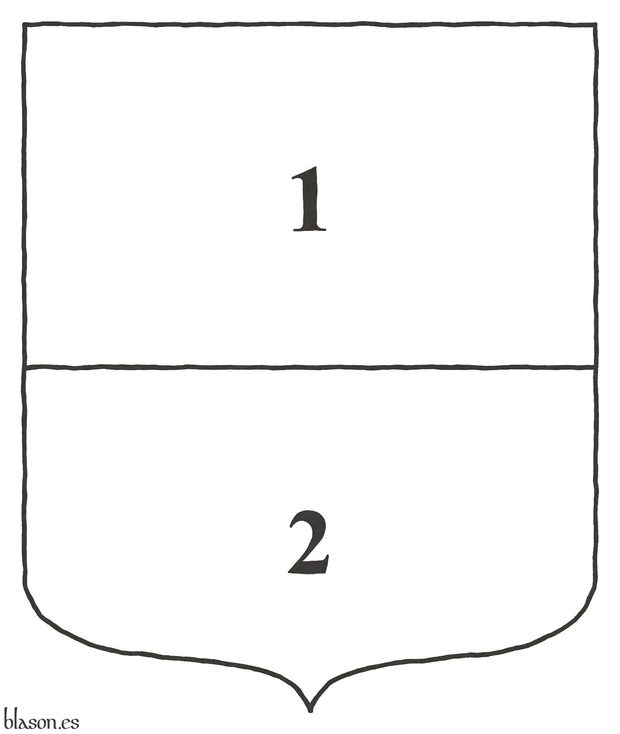
José de Avilés e Iturbide, Marquis of Aviles, member of the Supreme Council of War, «Ciencia heroyca, reducida a las leyes heráldicas del blasón: Ilustrada con exemplares de todas las piezas, figuras y ornamentos de que puede componerse un escudo de armas interior y exteriormente, Tomo II», edition of Joaquín Ibarra, printer of his Majesty's Chamber, at the expense of the Company of Printers and Booksellers of the Kingdom, 440 pages, Madrid, 1780.
The first edition is [Avilés, J.; 1725b] and this edition is 14 years after the death of José de Avilés, that happened in 1766.
Helm of squire, knight, 39, and hidalgo, 40
Bibliographical reference of century XVIII.
Classification: In black and white and Castilian language.
The author is Avilés e Iturbide, José.
The following articles cite this bibliographic reference:
- Alcantara, Order of
- Avilés, J.; 1725b
- Calatrava, Order of
- David B. Appleton, slipped and leaved
- Godfrey V, Count of Anjou
- Montesa, Order of
- Order of Alcantara, emblem
- Order of Calatrava, emblem
- Order of Montesa, emblem
- Order of Santiago, emblem
- Santiago, Order of
External resource:


![Ver [Menestrier, C. F.; 1750] en referencias bibliográficas. Libro abierto, hojas de plata, filo de oro, guardas de gules, tapas de sable.](../css/Libro.Bibliografia.png)
Menestrier, C. F.; 1750
Claude-François Menestrier, member of the Society of Jesus, «La Nouvelle Methode Raisonnée du Blason pour l'Aprendre d'une Maniere Aisée: Reduite en Leçons par Demandes, Et par Réponses», «Auec Privilege du Roy» ~ with the privilege of the king, 298 pages accompanied by additional tables, Lyon, 1750.
Method
The central part of the book functions primarily as a dictionary, where heraldic terms are presented with the text of a blazon that contains them and the drawing of the blazon that illustrates them. The blazon illustrations are grouped on plates organized in a format of 5 rows and 5 columns, displaying 20 coats of arms per plate.
Facsimile edition details
This volume, produced by Vernoy for Arnaud de Vesgre, features a faithful and complete reproduction of the text and illustrations from the 1750 edition of the work by C. F. Menestrier. It was printed on 160-gram laid paper and bound in genuine hand-marbled leather as done in the past. The front cover and spine were stamped using a balance press with 22-carat fine gold. Printed in Switzerland by Idégraf, production by I.C.E.D., Arnaud de Vesgre, edition number 516, Legal deposit 1979 - 06.79.
Bibliographical reference of century XVIII.
Classification: In black and white, Dictionary and French language.
Author: Menestrier, Claude-François.
Internal resources: A facsimile edition as a physical book on paper.


![Ver [Moreno de Vargas, B.; 1795] en referencias bibliográficas. Libro abierto, hojas de plata, filo de oro, guardas de gules, tapas de sable.](../css/Libro.Bibliografia.png)
Moreno de Vargas, B.; 1795
Bernabé Moreno de Vargas, Perpetual councilor of the City of Mérida, «Discourse on the Nobility of Spain», corrected and added by the same author, A.E., Madrid, printed in the printing house of Antonio Espinosa, year of M. DCC. XCV. 1795. available at Escribano's Bookstore, Carretas street, Madrid, 1795
Bibliographical reference of century XVIII.
Classification: Castilian language and In black and white.
Author: Moreno de Vargas, Bernabé.
Internal resources: MorenoDeVargasB1795.DiscursosDeLaNobleza.pdf.


![Ver [Nisbet, A.; 1722] en referencias bibliográficas. Libro abierto, hojas de plata, filo de oro, guardas de gules, tapas de sable.](../css/Libro.Bibliografia.png)
Nisbet, A.; 1722
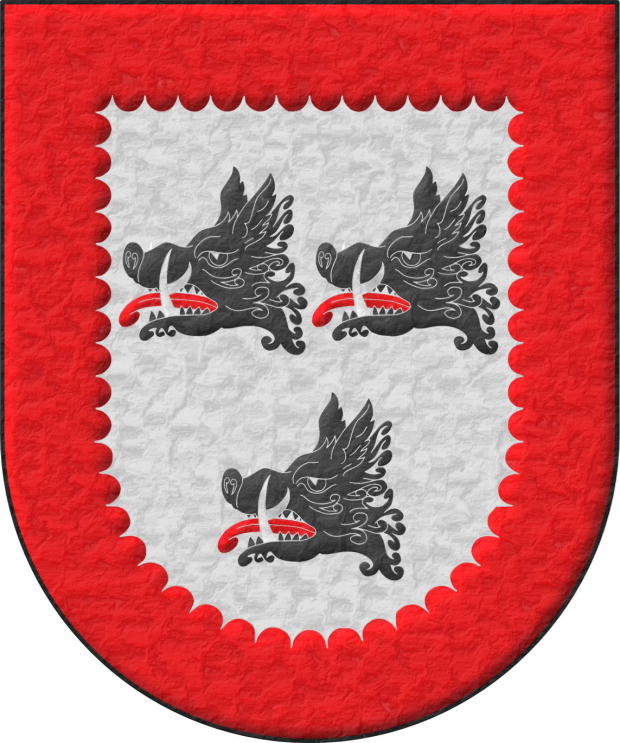
Alexander Nisbet, «System of Heraldry Speculative and Practical: With the True Art of Blazon», subtitle «according to the most approved heralds in Europe: illustrated with suitable examples of armoria figures, and achievements of the most considerable surnames and families in Scotland, together with historical and genealogical memorials relative thereto», printed by J. MackEuen, Edinburgh, 1722.
This is the very 1st edition of this book and I consult the edition [Nisbet, A.; 1816].
Bibliographical reference of century XVIII.
Author: Nisbet, Alexander.
The following articles cite this bibliographic reference:
External resource:


![Ver [Pineda, Juan d.; 1783] en referencias bibliográficas. Libro abierto, hojas de plata, filo de oro, guardas de gules, tapas de sable.](../css/Libro.Bibliografia.png)
Pineda, Juan d.; 1783
Fray Juan de Pineda, «Libro del Passo Honroso, defendido por el excelente caballero Suero de Quiñones», compiled from an old handwritten book, second edition, 68 pages. printed by Antonio de Sancha, Madrid, 1783.
Fray Juan de Pineda, a Franciscan monk, compiled and abbreviated the original work by [Rodríguez de Lena, P.; Century XVI], in this edition, which is printed in a double-column format.
The book begins with the title «Comiénzase el libro del Passo Honroso: abreviado por fr. Juan de Pineda», which refers to the original work by Rodríguez de Lena. The main text recounts the heroic acts of Suero de Quiñones and his companions, detailing their 30-day defense of the Órbigo bridge against all challengers.
The book includes the full list of the 10 defenders, or maintainers, on page 67, and the 68 conquerors, or adventurers, on pages 67 and 68, and reports the results of the jousts for all of them.
Bibliographical reference of century XVIII.
Classification: Castilian language and In black and white.
Author: Pineda, Juan de.
Bibliographical reference mentioned in the following article:
External resource:
Internal resources: PinedaJ1783.PassoHonroso.pdf PDF Format.


![Ver [Porny, M. A.; 1765] en referencias bibliográficas. Libro abierto, hojas de plata, filo de oro, guardas de gules, tapas de sable.](../css/Libro.Bibliografia.png)
Porny, M. A.; 1765
Mark Anthony Porny, French Master at Eton College, «The Elements of Heraldry», 198 numbered pages and an unnumbered dictionary of 38 pages, illustrated with 23 plates, 8vo, octavo, printed for J. Newbery, in Saint Paul's Church-Yard, London, 1765.
Contents according to the author's description
- A clear definition and concise historical account of that ancient, useful, and entertaining science.
- The origin, antiquity, and diverse kinds of coats of arms, with their essential and integral parts considered separately.
- The several sorts of escutcheons, tinctures, charges, and ornaments used for coats of arms.
- The marks whereby bearers of the same coat of arms are distinguished from each other.
- Charges formed of ordinaries, celestial figures, animals, birds, fishes, vegetables, artificial, and chimerical figures.
- The laws of heraldry, practical directions for marshalling coats of arms, and the order of precedence.
- To which is annexed, a dictionary of the technical terms made use of in heraldry.
Bibliographical reference of century XVIII.
Classification: De bibliotheca, English language and In black and white.
The author is Porny, Mark Anthony.
Internal resources: Physical book on paper.


![Ver [Stych, F. S.; 1722] en referencias bibliográficas. Libro abierto, hojas de plata, filo de oro, guardas de gules, tapas de sable.](../css/Libro.Bibliografia.png)
Stych, F. S.; 1722
F. S. Stych, University of Sheffield, «The Flow Chart Method and Heraldic Enquiries» RQ, volume 6, number 4, pages 169-174, published by American Library Association, Chicago, summer of 1967.
This article describes, using a flowchart, a method to identify the holder of a coat of arms. This method is applicable to the armories of the United Kingdom, as it follows their heraldic norms and most important sources. One of the target readers of the article are librarians who, finding coats of arms in books, plates, ex libris, etc., need to classify them.
The most notable aspect of the article is the 1967 flowchart, which is shown in the image above. This image has been extracted, cleaned, and enhanced from the original diagram contained at the end of the article. Note that some functions appear repeated within the scheme, such as, «Check families listed in Anson, etc. in Burke's General Armory. Arms found?» which, in turn, is represented with a task rectangle, when it really is a rectangle containing a question, a bifurcation, which should be a diamond «Arms found?», that is, it has been represented by a rectangle what should have been represented by a rectangle and a diamond. This same issue occurs in other processes and is probably due to not complicating the flowchart further.
Bibliographical reference of century XVIII.
Author: Stych, F. S..


![Ver [Vega, P. J. de; 1702] en referencias bibliográficas. Libro abierto, hojas de plata, filo de oro, guardas de gules, tapas de sable.](../css/Libro.Bibliografia.png)
Vega, P. J. de; 1702
Pedro José de Vega, «Compendio de la Maior Parte Ð los Blassones, Armas, e Ynsignias Ð las Ylustres Casas, Familias, y Apellidos del Reyno Ð Navarra i Parte Ð la Provincia de Gvipvzcoa, Segvn las Vsan y Traen los Svccesores Ðellas» ~ «Compendium of the Greater Part of the Blazons, Arms, and Insignias of the Illustrious Houses, Families, and Surnames of the Kingdom of Navarre and Part of the Province of Guipuzcoa, As Used and Carried by Their Successors», manuscript in 2 volumes, Volume I, catalog number MSS/7835 V.1, and Volume II, catalog number MSS/7836 V.2, in the National Library of Spain, 1702.
As stated on the title page, the Field Master «Pedro Ioseph Ð Vega» was a native of the Kingdom of Navarre, deputy of the Kingdom of Navarre from 1688 to 1691, governor of the provinces of Cotabamba and Parinacochas in Peru, written as «governador», and gentleman of the «Voca de su Majestad» (His Majesty's Voice).
Bibliographical reference of century XVIII.
Author: Vega, Pedro José de.
Here are the articles quoting this reference:
- Almorrabides of Navarre
- Aybar of Navarre
- Baztanes of Navarre
- Guebara of Navarre
- Lete of Navarre
- Mauleón of Navarre
- Monteagudo of Navarra
- Navarra, emerald overall
- Qasqante of Navarre
- Rada of Navarre
- Subiça of Navarre
- Urroz of Navarre
- Vidaurre of Navarre
External resource:
-
Language
-
Categories of heraldry
-
Divisions of the field
- Without divisions
- Party per pale
- Party per fess
- Party per bend
- Party per bend sinister
- Tierce
- Tierce sinister
- Tierced per pale
- Tierced per fess
- Tierced per bend
- Tierced pallwise inverted
- Quarterly
- Quarterly per saltire
- Gyronny
- Party per fess, the chief per pale
- Party per pale, the sinister per fess
- Party per fess, the base per pale
- Party per pale, the dexter per fess
- Chapé
- Chaussé
- Embrassé
- Contre-embrassé
- Party per chevron
- Enté
- Enté en point
- Flanched
-
Metals
-
Colours
-
Furs
-
Other tinctures
-
Ordinaries and sub-ordinaries
-
Diminutives of the ordinaries
-
Geometric charges
-
Composite ordinaries
-
Inanimate charges from Nature
Atom, Crescent, Diamond, Emerald, Estoile, Increscent, Lightning flash, Moon, Mount, Mullet, Mullet of four points, Orbital, Plough of Ursa Major, Rainbow, Ray of the sun, River, Sea, Snowflake, Sun, Sun in splendour, Sun of May, Trimount, Water and Wave.
-
Vegetal charges from Nature
Acorn, Apple, Apple tree, Ash, Bluebonnet, Camellia, Chrysanthemum, Cinquefoil, Cornflower, Dogwood flower, Double rose, Elm, Fleur de lis, Flower, Gourd, Holm oak, Hop cone, Kapok tree, Laurel, Lily, Linden, Lotus flower, Madonna lily, Mexican cedar tree, Oak, Olive tree, Palm tree, Plantain plant, Pomegranate, Poplar leaf, Rose, Shamrock, Sunflower, Thistle, Tree, Tulip, Vine and Wheat.
-
Animal charges from Nature
Badger, Bald eagle, Barbel, Barn owl, Bear, Beaver, Beetle, Bighorn sheep, Blackbird, Boar, Brach hound, Bull, Doe, Dog, Dolphin, Dove, Eagle, Elephant, Falcon, Female figure, Fish, Flame, Fly, Fox, Frog, Goat, Goldfinch, Goose, Heron, Horse, Hummingbird, Jaguar, Lark, Leopard, Lion, Lion passant, Lion rampant guardant, Lioness, Lynx, Male figure, Martlet, Merino ram, Owl, Panther, Parrot, Peacock, Pelican, Pelican in her piety, Puffin, Quetzal, Raven, Roe deer, Rooster, Savage, Seagull, Serpent, She-wolf, Stag, Starling, Talbot, Tyger, Vulture, Warren hound and Wolf.
-
Parts of natural charges
Arm, Beak, Branch, Caboshed, Chest, Claw, Covert, Dorsal fin, Eagle claw, Ermine spot, Escallop, Feather, Foot (palmiped), Foreleg, Forepaw, Hand, Head, Heart, Hoof, Leaf, Neck, Ostrich feather, Palm frond, Paw, Roe deers' attires, Shoulder, Sprig, Stags' attires, Stem, Swallow-tail, Tail, Tail addorsed, Tail fin, Talon, Tooth, Trunk, Trunk (elephant), Two hands clasped, Two wings in vol, Udder, Wheat spike, Wing and Wrist.
-
Artificial charges
Ace of spades, Anchor, Anvil, Arch, Arm vambraced, Armillary sphere, Arrow, Axe, Bell, Bell tower, Beret, Bonfire, Book, Bookmark, Bow, Branding iron, Bridge, Broken, Buckle, Cannon, Cannon dismounted, Cannon port, Canopy roof, Carbuncle, Castle, Celtic Trinity knot, Chain, Chess rooks, Church, Clarion, Clay pot, Closed book, Club, Column, Comb, Compass rose, Conductor's baton, Cord, Covered cup, Crozier, Crucible, Cuffed, Cup, Cyclamor, Dagger, Double vajra, Drum, Ecclesiastical cap, Fanon, Federschwert, Fleam, Four crescents joined millsailwise, Galician granary, Garb, Gauntlet, Geometric solid, Grenade, Halberd, Hammer, Harp, Host, Hourglass, Key, Key ward, Knight, Knot, Lantern, Letter, Line, Loincloth, Menorah, Millrind, Millstone, Millwheel, Monstrance, Mortar, Mullet of six points pierced, Nail, Non-classic artifact, Norman ship, Number, Oar, Oil lamp, Open book, Page, Pair of scales, Parchment, Pestle, Piano, Pilgrim's staff, Plough share, Polish winged hussar, Port, Portcullis, Potent, Quill, Ribbon, Rosette of acanthus leaves, Sabre, Sackbut, Sail, Scroll, Scythe, Sheaf of tobacco, Ship, Skirt, Spear, Spear's head, Stairway, Star of David, Step, Sword, Symbol, Tetrahedron, Torch, Tower, Trident, Trumpet, Turret, Two-handed sword, Wagon-wheel, Water-bouget, Wheel, Winnowing fan and With a turret.
-
Immaterial charges
Angel, Archangel, Basilisk, Dragon, Dragon's head, Garuda, Golden fleece, Griffin, Heart enflamed, Justice, Mermaid, Our Lady of Mercy, Ouroboros, Paschal lamb, Pegasus, Phoenix, Sacred Heart of Jesus, Saint George, Sea-griffin, Trinity, Triton, Unicorn, Winged hand and Wyvern.
-
External elements
-
Heraldic creations
-
References
-
Formats
-
Keywords on this page
Invected, Armorial roll, Erased, Azure, Bibliography, Bordure, Head, Five, Crown, Crown of Count, Party per fess, De bibliotheca, Tusked, Dictionary, In black and white, Schema, Mullet, Gules, Infamed, Boar, Langued, Castilian language, French language, English language, Lineage, Manuscript, Or, Canting, Party per pale, Argent, Without divisions, Clay pot, Kingdom of Navarre, Sable and Century XVIII.

